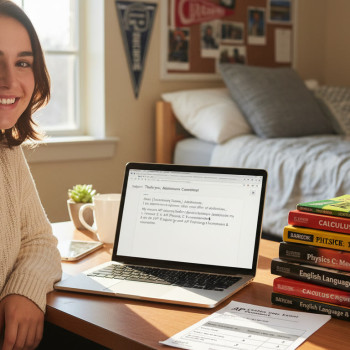Introduction: Why Back-to-Back AP Weeks Need a Plan
Two, three, sometimes four AP exams within a week can feel like running a sprint relay while juggling a backpack. You’re not just being tested on content — you’re being tested on stamina, focus, and strategy. The good news: small, practical changes to sleep, food, and pacing make a huge difference. This post lays out a friendly, human, and evidence-informed roadmap you (and your parents) can follow to get through consecutive exam days with confidence and clarity.

First Principles: What Really Matters During Exam Weeks
Before we dig into tactics, let’s set three guiding principles that shape the rest of the plan:
- Prioritize recovery over last-minute cramming. Your brain needs consolidation (sleep and nutrition) to translate study into recall. A tired mind performs worse than a refreshed one, even if you think you “know” the material.
- Control what you can. You can’t change the schedule of the College Board, but you can control bedtime, meals, micro-breaks, and your pacing strategy during the exam.
- Consistency beats intensity. Small, steady habits will keep your cognitive system stable through multiple test days.
Sleep: The Non-Negotiable Exam Week Weapon
Why sleep matters more than an extra cram session
Sleep is the unseen study tool. Memory consolidation — the process of transferring facts and procedures from short-term to long-term memory — happens during deep sleep and REM cycles. Shortchanging sleep to cram often leaves you able to recognize information (familiarity) but not to retrieve it under pressure (recall).
Practical sleep rules for exam weeks
- Anchor your schedule: Pick a consistent bedtime and wake time you can maintain for the whole exam period (including the weekend between exam weeks). Aim for 8–9 hours if possible; 7 is the lower limit for high school students under stress.
- Wind-down routine (45–60 minutes): No screens with bright blue light. Replace scrolling with low-stakes activities: light reading (not review sheets), breathing exercises, or a short walk earlier in the evening.
- Nap smart: Keep naps to 20–30 minutes and avoid napping late afternoon. A short nap after lunch on non-exam afternoons can boost alertness without damaging night sleep.
- Pre-exam night: Aim to be in bed earlier than usual the night before the first of consecutive exams. It’s better to bank sleep beforehand than try to recover after the first test.
Food and Hydration: Small Wins That Add Up
Guiding idea: steady energy, not spikes
You want a steady release of energy and a calm stomach during the exam. That means balancing protein, complex carbohydrates, and healthy fats for slow-burning fuel — and staying hydrated.
Meal and snack blueprint
- Breakfast (pre-exam): Protein + complex carb + fruit. Examples: Greek yogurt with oats and berries; whole-grain toast with peanut butter and banana; scrambled eggs and a small whole-grain wrap.
- Snack (arrival or mid-morning break): Hand-sized and familiar: a banana, a small trail mix (nuts and dried fruit), or an energy bar you’ve tried before. Avoid very high-sugar treats that cause energy crashes.
- Lunch (if you have an afternoon exam): Lean protein, whole grains, and veggies. Think turkey sandwich on whole-grain bread, a quinoa bowl with roasted veggies and chickpeas, or a salad with grilled chicken and a simple dressing.
- Hydration: Sip water consistently from morning to exam; avoid chugging right before you go in. Limit excess caffeine: a small familiar amount can sharpen focus, but too much can increase anxiety and interfere with sleep.
Foods to avoid on test days
- Very greasy or heavy meals that slow you down.
- New foods that might upset your stomach — exam days are not the time for culinary experimentation.
- Large quantities of simple sugar or energy drinks.
Pacing Your Study and the Exam: Simple Systems
Before exam week: micro-blocked review
Two weeks before your first exam, switch from broad studying to focused micro-blocks: 25–40 minute review sessions with a single objective (e.g., “practice free-response questions on Topic X” or “memorize 10 key equations”). This prevents fuzzy, last-minute blanket cram sessions.
Daily pacing during consecutive exam days
Each exam day has a rhythm: pre-exam routine, test performance, recovery window. Plan each day around that rhythm so your energy never drops off a cliff.
- Morning (2–3 hours before exam): Light review: look over formulas, quick flashcards, or a one-page sheet of ‘must-remember’ items. No heavy studying that could increase stress.
- Just before exam (30 minutes): Gentle warm-up: breathing, review a known anchor (a mnemonic or quick fact sheet), hydrate, snack if needed.
- After exam (first 90 minutes): Recovery and light reset: eat, move a little, and power down intense study. Your brain consolidates better when not overloaded immediately.
- Late afternoon or evening: If you have another exam, do one short review block for the next subject (30–45 minutes), followed by calming routines; avoid marathon sessions.
Sample Two-Day Back-to-Back Plan
Below is a sample schedule for two consecutive exam days: an 8:00 AM exam followed by a 1:00 PM exam the same day, then a second-day 8:00 AM exam. Adjust times to match actual exam start times and travel needs.
| Time | Day 1 (8 AM & 1 PM) | Day 2 (8 AM) |
|---|---|---|
| 6:00 AM | Wake, light stretching, 15–20 min quick review sheet, breakfast (protein + carb) | Wake, hydration, short review, breakfast |
| 7:00 AM | Arrive early, final calm review, bathroom, sip water | Arrive early, calm focus |
| 8:00–11:00 AM | Exam 1 — follow pacing strategy; immediately after: eat small protein-rich snack | Exam — same routine |
| 11:30 AM | Lunch: steady meal; 20-minute walk to reset | — |
| 1:00–4:00 PM | Exam 2 — use time blocks inside the test (see tips below) | — |
| 5:00 PM | Light review for next day (30–40 minutes) — strictly targeted | Evening recovery: dinner, wind-down, earlier bedtime |
| 9:00–10:00 PM | Bedtime routine: screens off, relaxation, sleep by target time | Sleep early to bank rest |
Inside the Exam: Pacing Strategies for Different AP Formats
Multiple-choice sections
Start with a quick scan to mark easy questions. Use a two-pass approach:
- Pass 1: Answer all questions you can do quickly (about 60–70% of the section).
- Pass 2: Return to medium-difficulty questions. Mark the hardest ones and make an educated choice if time runs low.
- Time check: Put small time checkpoints on your test booklet (for instance, “halfway mark” and “10 minutes left”) so you don’t get surprised.
Free-response sections
Familiarize yourself with the rubric and score distribution in advance so you can allocate time by point value. For example, if a question is worth 10 points and you have 45 minutes, consider spending roughly 12–15 minutes per major question with built-in time to proofread.
- Quick outline (1–2 minutes) for each response before writing.
- Label parts clearly (a, b, c) to help graders follow your logic — clarity often earns points.
- Reserve 3–4 minutes at the end of each response to add any missing keywords or equations.
Practice this pacing before exam week
Take timed practice sections under realistic conditions. The familiarity of the pacing beats the adrenaline that comes when a clock is staring you down for the first time on test day.
Stress Management: Quick Tactics You Can Do Anywhere
- Box breathing: Inhale 4 seconds, hold 4, exhale 4, hold 4. Do this 3–5 times to reduce heart rate and sharpen attention.
- Grounding technique: Name 5 things you see, 4 you can touch, 3 you hear, 2 you smell, 1 you taste to pull focus away from catastrophic thoughts.
- Mantras: Short, factual reminders like “One question at a time” or “I prepared; I will do my best” can reduce rumination.
How Parents Can Help Without Adding Pressure
Parents play a huge role during back-to-back weeks by supplying structure and emotional stability. Here’s what helps most:
- Logistics: Pack exam-day breakfasts and snacks you’ve agreed on. Ensure reliable transportation and a quiet recovery space at home.
- Emotional support: Ask open-ended questions and model calm. Avoid re-quizzing right before the exam; validation is more helpful than last-minute instruction.
- Sleep guardianship: Encourage earlier bedtimes, and gently enforce screen-limits in the evening.
Sparkl’s Role: When Personalized Help Makes the Difference
General strategies are useful, but students with mixed subject loads or unique timing needs often benefit from tailored plans. Sparkl’s personalized tutoring is ideal when you want:
- 1-on-1 guidance to prioritize topics by likelihood and student weakness.
- Tailored study plans that fit around family schedules and consecutive exam days.
- Expert tutors who model pacing during practice tests and provide AI-driven insights into which question types to prioritize.
Built-in accountability and a tutor’s calm voice can turn worry into a focused plan — especially when exam days pile up.
Checklist: The Exam-Week Carry-On
- Printed admission ticket and photo ID (double-check the exact documents required).
- Small, familiar snacks and a reusable water bottle.
- Watch (non-smart if the testing center requires it) or a clear time-check method.
- Warm layers for varying test-room temperatures.
- Quick review sheet (one page) for pre-exam calm review, folded into your pocket.
- Phone turned off and packed away until after the exam.
Real-World Example: Two Students, Two Approaches
To make this concrete, here are two short vignettes that show how choices matter.
- Sam (planned and steady): Sam focused on sleep and practiced timed sections twice a week. On back-to-back days, Sam used the micro-block review sheet, ate a balanced breakfast, and took short walks to reset. The measured approach prevented panic and produced steady performance across exams.
- Jada (last-minute cram): Jada stayed up late trying to relearn topics and slept 4–5 hours before the first exam. She felt foggy on the multiple-choice section even though she had reviewed the material — the missing sleep blunted retrieval. After that, she used recovery time poorly and underperformed on the second exam.
The difference was not raw intellect; it was strategy and recovery.
Frequently Asked Questions
Q: Is it okay to skip breakfast to avoid nervous stomach?
A: Not usually. A small, bland, protein-rich breakfast is better than skipping. If you’re prone to queasiness, test a few breakfast options in practice to find a safe, familiar choice.
Q: Should I review right up until the bell?
A: No. Your last 20–30 minutes before the exam should be calming — quick cues only. Heavy review can increase anxiety and reduce focus right as the exam begins.
Q: How much caffeine is too much?
A: Stick to the amount you normally use. If you don’t routinely have coffee, test day is not the time to start. For regular users, a modest cup can help; avoid multiple energy drinks and late-afternoon caffeine that might disrupt sleep.
Action Plan You Can Start Today
- Choose your bedtime and wake time for the full exam period and commit to it.
- Draft one-page review sheets for each subject and practice the pacing you’ll use during the test.
- Create a simple meal plan for exam days with breakfasts and snacks you’ve tried before.
- Schedule one timed practice exam under realistic conditions to test pacing and logistics.

Closing Thought: Treat Exam Weeks Like Athletic Performance
Top athletes don’t treat competition as a single event — they prepare sleep, nutrition, warm-ups, and recovery. Think of back-to-back AP weeks the same way. The content knowledge matters, of course, but the edge comes from how you sleep, what you eat, and how you pace both studying and the exam itself.
If you want a customized pacing plan (for example, if your exams fall on unusual days or you juggle extracurriculars and long commutes), consider a short series of personalized sessions. Tutors — like those at Sparkl — can help you prioritize, simulate exam pacing, and smooth out logistics so you head into test week feeling prepared rather than panicked.
Final Checklist — One Page To Take With You
- Sleep: Bed by target time; 7–9 hours where possible.
- Food: Balanced breakfast, small snack, water; avoid new foods and heavy sugar.
- Pacing: Two-pass approach on MCQ, outlined responses for FRQs, timed practice beforehand.
- Stress: Practice breathing and grounding; use short mantras.
- Logistics: Tickets, ID, watch, layers, and a one-page calm review sheet.
You’ve studied. You’ve practiced. Now treat your body like part of the test-taking team — give it rest, fuel it right, and pace it well. When exam day comes, you’ll be ready to show what you know.
Good luck — you’ve got this.
















No Comments
Leave a comment Cancel